1. Introduction
Forensic science or Forensic evidence serves as the backbone of modern legal systems, providing a factual basis for the investigation and prosecution of crimes. Its emergence has revolutionized the criminal justice landscape, transitioning from a reliance on witness testimony to an evidence-based approach that can objectively link suspects to crimes—or exonerate the innocent.
a. Definition and Scope of Forensic Evidence
Forensic evidence encompasses any information or material obtained through scientific methods suitable for use in a court of law. It’s not merely a tool for crime-solving; it’s also instrumental in the broader judicial process, helping establish the occurrence of a crime, identifying the perpetrator, and exonerating the wrongfully accused. The scope of forensic evidence is vast, ranging from DNA profiles to digital footprints, each with its unique set of collection, analysis, and presentation challenges.
b. Significance of Forensic Science in Modern Legal Systems
The modern legal system hinges on the ability to present tangible, incontrovertible evidence. Forensic science contributes to this by offering methods to analyze the physical and digital remnants of criminal activity. Its significance is amplified in complex cases where the narrative does not align neatly with the available testimonial evidence, or where such evidence is unavailable.
c. The Indian Context: An Overview
In India, the use of forensic evidence is governed by a complex legal framework. While the country has seen a significant increase in the use of forensic science, spurred by high-profile cases and growing awareness, challenges remain. These include infrastructure limitations, the need for skilled experts, and a legal system that is still adapting to the nuances of scientific testimony.
d. Types of Forensic Evidence
A myriad of forensic evidence types is utilized within the Indian criminal justice system:
- DNA Evidence: Offers genetic fingerprinting that can uniquely identify individuals.
- Fingerprint Analysis: One of the oldest and most reliable forms of forensic evidence.
- Ballistic Evidence: Provides insight into the use of firearms in a crime.
- Digital Forensics: Pertains to the recovery and investigation of material found in digital devices, increasingly important in the age of cybercrime.
- Toxicology: Involves the analysis of bodily fluids for poisons and other substances.
These and other forms of evidence each play a pivotal role in the investigation and adjudication process.
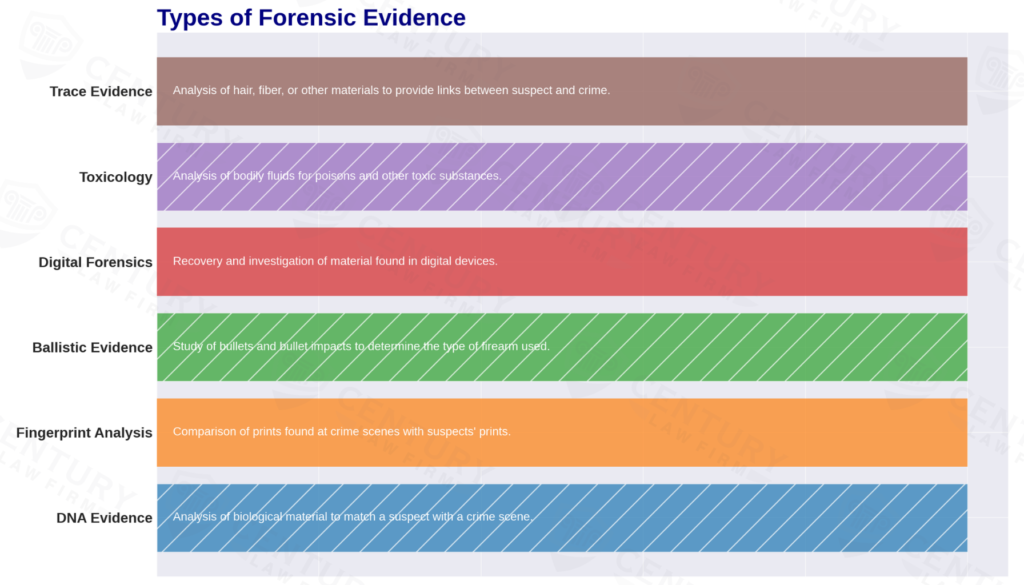
2. Historical Development
The journey of forensic science in India is as fascinating as it is complex, intertwining with the nation’s evolving legal landscape. The interplay between medical expertise and criminal investigations has existed since ancient India, with references in Indian epics. But modern forensic science really took root in the late 19th century colonial era.
a. The Genesis of Forensic Science in India
Forensic science in India can trace its origins to the colonial era, with the establishment of the first fingerprint bureau in the world in Calcutta, now Kolkata, in 1897. This was a monumental step in the adoption of scientific techniques in crime investigations.
b. Milestone in Forensic Legislation
The legal framework that would govern the use of forensic evidence began with the Indian Evidence Act of 1872, which set the stage for expert testimony in Indian courts. However, it would take several amendments and judicial interpretations to refine the scope and application of this evidence.
c. Key Judgements and Their Impact on Forensic Practices
Over the years, Indian courts have delivered landmark judgments that have influenced the acceptance and reliance on forensic evidence. These judgments have not only shaped the legal precedents but have also prompted procedural reforms in how forensic evidence is collected, preserved, and presented in court.
d. Establishment of Forensic Science Labs in India
The rationale behind setting up dedicated forensic science laboratories (FSLs) in India was to provide a professional and scientific approach to crime investigations. The first such lab was established in 1952, signifying a commitment to elevating the role of science in legal proceedings.
In the following sections, we will delve into the legal framework, categorization of evidence, and the standards of admissibility, laying the foundation for understanding the intricate relationship between forensic science and the Indian criminal justice system.
3. Legal Framework and Provision
The legal acceptance and treatment of forensic evidence in India are rooted in a combination of British-inherited laws and India’s own evolving legal statutes and judicial interpretations.
a. The Indian Evidence Act, 1872
This cornerstone legislation defines the admissibility of evidence in Indian courts and lays the groundwork for the use of expert testimony.
i. Expert Testimony: Section 45 Analysis
Section 45 of the Indian Evidence Act permits the opinions of experts to be considered in matters of science, art, or foreign law where the court deems it necessary. This includes forensic experts whose insights are crucial to interpreting technical evidence. For example, in the landmark judgment of State of Himachal Pradesh vs. Jai Lal and Others, the Supreme Court underscored the need for a cautious approach while dealing with expert opinions, emphasizing the experts’ role as aides to the judges.
ii. Evidence Classification: Understanding Section 3
Evidence in Indian law is broadly categorized into oral and documentary. Forensic evidence, while often derived from physical objects, is usually presented in the form of expert reports and thus is considered documentary. The Evidence Act under Section 3 also recognizes ‘evidence’ as including electronic records, which becomes increasingly relevant with the rise of digital forensics.
b. Procedural Laws: CrPC and IPC Overview
The Code of Criminal Procedure (CrPC) and the Indian Penal Code (IPC) provide the procedural backbone for criminal proceedings. The CrPC outlines the procedures for collecting evidence, including forensic evidence, ensuring its integrity through the chain of custody and sanctioning its analysis by forensic laboratories. The IPC defines offenses and prescribes punishments where forensic evidence often plays a pivotal role in establishing the guilt or innocence of the accused.
c. Jurisprudence and Precedents
Judicial precedents shape the practical application of forensic evidence in India. The courts, through various judgments, have provided clarity on the nuances of forensic evidence.
i. Supreme Court Directives
The apex court has issued directives to standardize the treatment of forensic evidence. For instance, in Selvi & Ors. v. State of Karnataka, the Supreme Court addressed the admissibility of narco-analysis, brain mapping, and polygraph tests, framing guidelines for their use.
ii. High Court Observations
High courts across India have also contributed to the jurisprudence on forensic evidence. Their observations often involve the interpretation of the Evidence Act in light of emerging scientific advancements.
iii. Lower Court Applications
The lower courts are typically the first to encounter and apply forensic evidence in criminal trials. Their application of forensic science is informed by higher court rulings and the established procedures within the CrPC.
d. Supreme Court Judgments Shaping Forensic Evidence Rules
The Supreme Court’s judgments have had a profound impact on the use of forensic evidence. For example, guidelines were laid out for DNA testing in paternity disputes, which have since been applied in criminal cases as well.
In summary, the legal framework governing forensic evidence in India is a complex tapestry woven from the Indian Evidence Act, procedural laws, and a multitude of judicial decisions. Each case that leverages forensic evidence serves to refine the legal principles and practices surrounding its admissibility and application.
4. Categorization of Forensic Evidence
The Indian criminal justice system recognizes a variety of forensic evidence types, each with its own set of investigative techniques and legal considerations.
a. Biological Evidence or Medical Forensics
Biological evidence refers to any sample of biological material — such as hair, tissue, bones, teeth, blood, semen, or saliva — from which DNA can be extracted.
i. DNA Profiling: Advancements and Applications
DNA profiling has become a staple of forensic investigation due to its high degree of reliability. Advancements in DNA technology, such as STR (Short Tandem Repeat) analysis and mitochondrial DNA profiling, have increased the accuracy of matching samples to individuals. The DNA evidence plays a crucial role in linking the accused to the crime, setting a precedent for its admissibility.
ii. Blood Typing and Serological Analysis
Blood typing can exclude suspects who do not match the blood type found at a crime scene. Serological analysis further examines the proteins and enzymes in bodily fluids, providing a more detailed genetic picture. Although not as definitive as DNA profiling, these methods are still valuable investigative tools.
For example, in the 2012 Nirbhaya rape case, DNA evidence was critical in identifying and convicting the perpetrators.
Biological evidence like semen and hair samples can be pivotal in sexual assault cases to identify the perpetrator and establish lack of consent.
iii. Postmortem Reports
Postmortem reports, often referred to as autopsy reports, are vital documents in forensic science. They provide a detailed account of the findings from an examination of a deceased individual. These examinations are critical in determining the cause and manner of death, whether it be from natural causes, accidental incidents, or foul play.
An autopsy can reveal various pathologies, including those that may not have been apparent prior to death. It involves a thorough examination of the body, including the internal organs, and may also include toxicological testing to identify any chemicals, drugs, or poisons present in the body. The findings in postmortem reports are crucial for establishing timelines in criminal investigations and can provide substantial evidence in court, especially in cases of suspected homicide or unexplained death.
iv. Medico-Legal Certificates (MLC)
Medico-Legal Certificates are documents issued by medical practitioners or hospital authorities that record the examination findings of individuals who have sustained injuries under circumstances that suggest a criminal offense. An MLC includes detailed descriptions of the injuries, the possible instruments used, the time frame of the injuries relative to the examination, and any other observations that could be relevant for legal proceedings.
MLCs are often required when individuals are brought into a medical facility under conditions that suggest assault, abuse, traffic collisions, or any incident that could lead to legal action. These certificates serve as an official record that law enforcement and judicial systems rely on for evidence in cases involving bodily harm. They can help to corroborate testimonies, confirm or disprove alibis, and establish the severity and nature of the injuries sustained.
b. Physical Evidence
Physical evidence includes any material items that can be physically or chemically analyzed.
i. Fingerprinting Methods and Efficacy
Fingerprint analysis is one of the oldest forensic techniques. India’s unique contribution to fingerprinting — the Henry Classification System — is still in use worldwide.
ii. Trace Evidence: Fibers, Paint, and Other Materials
Trace evidence analysis can link a suspect to a crime by comparing materials found on them to those at the crime scene. This includes fibers, paint, glass, and soil, among others. The application of trace evidence was seen in the Nithari case (Noida serial murders), where forensic analysis of hair and clothing fibers was key to the investigation.
c. Digital Forensics
Digital forensics involves the recovery and investigation of data found in electronic devices, an area of growing importance in the digital age.
i. Cybercrime Investigations
With the rise of cybercrime, digital forensics has become central to identifying, collecting, and preserving evidence from computers and networks. The Pune Citibank MphasiS Call Center fraud is a case where digital forensic evidence was crucial in tracking down the perpetrators.
ii. Data Recovery and Analysis
Data recovery can retrieve deleted, encrypted, or damaged electronic information. The analysis of this data can reveal timelines, actions, and intentions, often pivotal in both cybercrime and cases involving digital evidence.
d. Chemical and Toxicological Evidence
This category includes the analysis of chemicals, drugs, poisons, and other substances found at a crime scene or within biological specimens.
i. Drug Analysis
Drug analysis not only identifies controlled substances but can also be used to trace their origin or determine the impairment of individuals. The Mumbai rave party raid in 2012, which led to multiple arrests, relied heavily on forensic toxicology reports.
ii. Poison Detection
Detecting poisons and their metabolites in biological specimens can be the decisive factor in cases of suspected poisoning. The conviction in the Rajasthan poison tiffin box case was largely due to toxicological evidence.
e. Psychological Forensics
Psychological forensics explores the mental state of individuals, offering insights into their behavior and potential for committing crimes.
i. Profiling and Behavioral Evidence
Profiling involves analyzing a criminal’s behavior patterns to predict their traits and future actions. This technique was notably used in the Shivani Bhatnagar murder case, where psychological profiling supported the investigation.
ii. Lie Detector Techniques
While not conclusively indicative of deception, lie detector tests such as polygraphs are used to support investigations. The Supreme Court, in Selvi & Ors. v. State of Karnataka, has held that involuntary administration of lie detector tests violates the right against self-incrimination.
f. Ballistic Evidence
Ballistic evidence pertains to the study of firearms and ammunition used in a crime.
The Ballistic analysis includes examining bullet trajectories, firearm mechanisms, and gunshot residues to determine aspects such as the type of weapon used and the distance from which a shot was fired. This form of evidence proved to be a linchpin in the Jessica Lal murder case, helping to establish the sequence of events.

The categorization of forensic evidence underlines the multifaceted nature of crime investigation and the need for specialized knowledge in interpreting each type. The following section will discuss the standards of admissibility for such evidence in Indian courts, which is vital for ensuring that only relevant, reliable, and properly obtained evidence influences judicial decisions.
5. Standard of Admissibility
The admissibility of forensic evidence in Indian courts is a critical aspect that determines its impact on judicial decisions. Various standards and procedural requirements are in place to ensure that the evidence presented is not only relevant but also reliable and legally obtained.
a. The Four Aspects of Admissibility in Indian Law
Forensic evidence in India must satisfy four primary aspects to be admissible:
- Relevance: The evidence must be pertinent to the case at hand, providing a direct or indirect connection to an event or individual involved in the crime.
- Legality: The evidence must be collected and presented in compliance with legal procedures and rights, including search and seizure laws and the right against self-incrimination.
- Reliability: The scientific validity of the methods used to collect and analyze the evidence must be established, often requiring validation by the scientific community.
- Credibility: The persons presenting the evidence, typically forensic experts, must be credible, with the requisite qualifications and absence of bias.
b. Establishing the Chain of Custody
A chain of custody is crucial for forensic evidence. It documents the evidence’s handling from the crime scene to the courtroom, ensuring that it has not been altered, tampered with, or contaminated. Breaks in the chain can lead to questions about the evidence’s integrity and may result in its exclusion.
c. Accuracy, Precision, and Reliability of Forensic Methods
The scientific techniques used must have a known error rate and be subject to peer review and standardization. For instance, DNA profiling has a high degree of accuracy, which is why it’s often deemed reliable in court. However, newer methods, like certain digital forensic techniques, may still be under scrutiny for their validity.
Understanding the Error Margins and Uncertainties in Forensic Evidence
While forensic evidence is a cornerstone of criminal investigations and legal proceedings, it is crucial to acknowledge that no analytical method is free from the possibility of error. The reliability of forensic evidence can be affected by a variety of factors, including the quality of the sample, the methodology used in analysis, and the interpretation of results.
Error Margins
Forensic methods come with inherent error margins that can range from negligible to significant, and these must be transparently communicated in forensic reports. For instance, DNA analysis is highly accurate, but the error margin, though small, becomes critical when determining guilt or innocence. Errors can arise from sample contamination, mislabeling, or interpretative mistakes during complex mixture analysis.
Uncertainty in Measurements
All measurements have some degree of uncertainty, a principle that holds true in forensic science as well. The degree of uncertainty can affect the interpretation of forensic evidence, particularly in disciplines like forensic toxicology, where the concentration of a substance can imply different things about consumption, impairment, or the time of intake.
Standard Error Rates
Standard error rates are established for various forensic techniques, which are derived from validation studies and proficiency testing. These rates help in understanding the probability of false positives or negatives. For instance, fingerprint analysis is subjective and depends on the examiner’s expertise, and while generally reliable, it has a known error rate that must be considered during evaluation.
Judicial Awareness
It is essential for the judiciary to be aware of these limitations. The justice system must critically evaluate forensic evidence, considering not only its weight but also the probability of error. Experts should present evidence along with its error margins to aid the court in making informed decisions.
Conclusion
Acknowledging the error margins and uncertainties does not diminish the value of forensic evidence. Instead, it strengthens the judicial process by ensuring that decisions are made with a full understanding of the evidence’s strengths and limitations. The continuous improvement in forensic methodologies and stringent quality controls are also vital in minimizing these errors, thereby enhancing the credibility and accuracy of forensic results.
d. Influence of Forensic Evidence on Judicial Decisions
Forensic evidence can profoundly influence the outcome of a case. In a landmark case, DNA evidence was pivotal in convicting the accused, illustrating the weight such evidence can carry. However, the judiciary also maintains caution, as seen in Ram Chander vs. State of Haryana, where the Supreme Court held that the forensic evidence should be corroborated with other evidence.
e. Expert Witness Requirements in Indian Law
Experts presenting forensic evidence must meet certain criteria:
- Qualifications: They must have specialized knowledge, skill, experience, training, or education in the relevant field.
- Impartiality: They should provide unbiased opinions based on the evidence.
- Relevance and Reliability: Their testimony must bear on the facts at issue and be scientifically valid.
Furthermore, the relevance and reliability criteria for scientific evidence are often influenced by landmark judgments. In State of Haryana vs. Bhagirath, the Supreme Court observed that scientific advances necessitate a progressive approach towards the acceptance of expert testimony, provided it meets the established criteria of reliability.
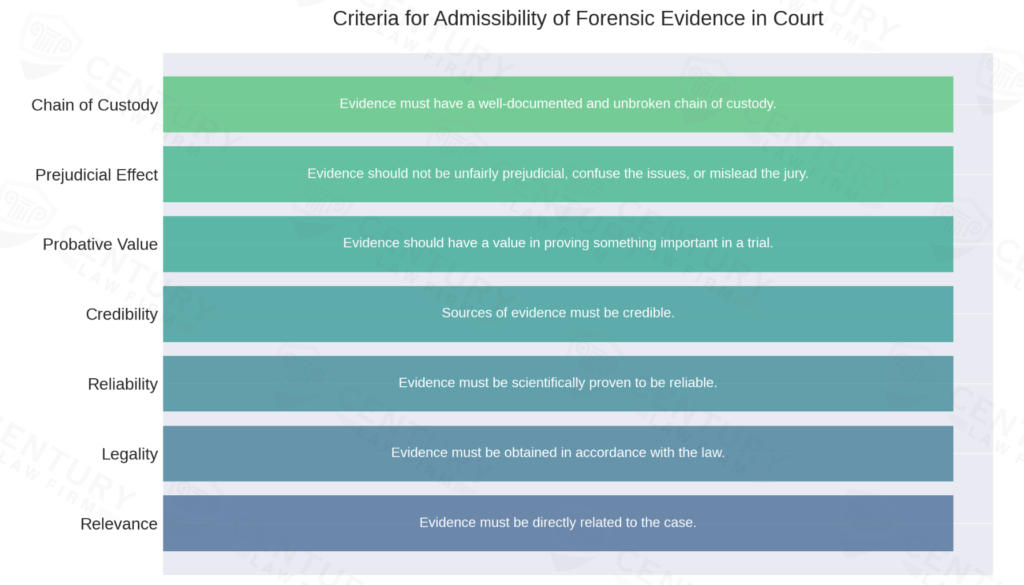
The admissibility standards ensure that forensic evidence contributes to the pursuit of truth without compromising the rights of the accused or the integrity of the judicial process. The next section will delve into the practical application of these standards and their real-world implications.
6. Practical Challenges and Future Outlook
The integration of forensic evidence within the Indian judicial system is not without its hurdles. Practical challenges often stem from limitations in infrastructure, training, and the intricate interplay between law and science. Nonetheless, the future holds promise for the increased use and sophistication of forensic techniques.
a. Infrastructure and Resource Limitations
India’s forensic infrastructure, while improving, still faces issues such as understaffing, underfunding, and lack of modern equipment. This can result in backlogs and delayed results, impeding the justice process. The Central and state governments have initiated various upgrades to forensic facilities, but the pace must be sustained to meet growing demands.
b. Training and Expertise of Forensic Professionals
The accuracy of forensic evidence is only as good as the experts who analyze it. There is a critical need for continuous professional development and training in the latest forensic methodologies. Collaborations with international bodies and institutions could bridge knowledge gaps and raise the standard of forensic practice in India.
c. Standardization and Quality Control
Standard operating procedures and quality control are vital for ensuring the reliability of forensic results. India is working toward standardized protocols, akin to the FBI’s Quality Assurance Standards for Forensic DNA Testing Laboratories, to enhance the credibility of forensic evidence presented in courts.
d. Legal Understanding of Forensic Science
The complexity of forensic science often poses challenges for legal professionals, including judges and lawyers, who may not have a scientific background. Increased emphasis on forensic literacy in legal education and the provision of scientific advisors to courts could alleviate misinterpretations of forensic evidence.
e. Noteworthy Cases and Their Outcomes
India has witnessed several landmark cases where forensic evidence played a crucial role:
- The Nirbhaya Case (2012): The brutal gang rape and murder led to widespread outrage and significant legal reforms. Forensic DNA evidence was critical in identifying and convicting the perpetrators.
- The Aarushi Talwar Murder Case: A highly publicized case where forensic lapses led to widespread criticism. The initial mishandling of the crime scene raised questions about the reliability of the evidence presented.
In counter-terrorism efforts, forensic techniques like explosive residue analysis and digital forensics are critical to uncovering terror plots and bringing perpetrators to justice.
f. Forensic Failures: Analysis of Wrongful Convictions
There have been instances where the misapplication of forensic evidence led to miscarriages of justice:
- The Naina Sahni Tandoor Murder Case: The case was complicated by the destruction of evidence. However, forensic methods managed to piece together the evidence, leading to a conviction.
- Wrongful Convictions: There are cases where individuals have been acquitted after years in prison due to faulty forensic analysis, emphasizing the need for accuracy and the potential human cost of errors.
g. Comparative Study: Indian Cases and International Benchmarks
Comparing forensic practices in India with those in jurisdictions like the United States or the United Kingdom highlights differences in resources, protocols, and technological access. For example, the FBI’s CODIS (Combined DNA Index System) is a benchmark for DNA database systems, which India is aspiring to emulate through initiatives like NAFIS (National Automated Fingerprint Identification System).
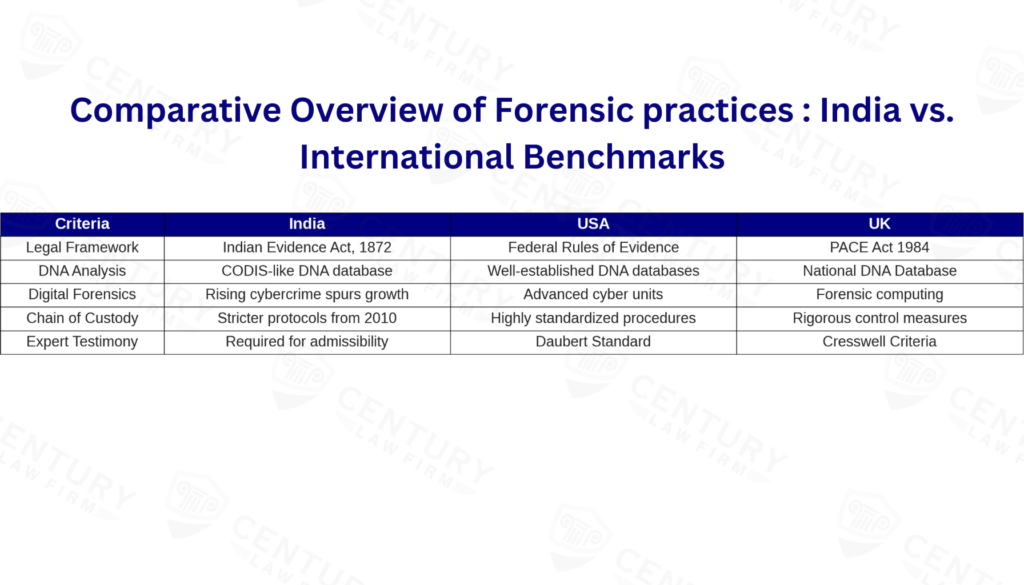
h. Forensic Science and Human Rights
The application of forensic science must align with human rights standards. Issues around consent for DNA collection, privacy concerns in digital forensics, and the ethical use of psychological profiling need careful navigation to protect individual rights while serving the interests of justice.
i. Technological Advancements and Their Integration
Emerging technologies like artificial intelligence, machine learning, and blockchain have the potential to transform forensic science. AI could assist in pattern recognition in digital forensics, while blockchain offers a secure way to maintain the chain of custody for digital evidence. Integrating these technologies requires updating legal frameworks and training law enforcement and judicial personnel.
j. International Cooperation in Forensic Investigations
As crime crosses borders, international cooperation becomes essential, particularly in cybercrime. India has sought to strengthen ties with other nations and international organizations to benefit from shared expertise and expedite cross-border forensic investigations.
k. Public Perception and Media Influence
The portrayal of forensic science in media, often dramatized, can affect public perception and create unrealistic expectations — a phenomenon known as the “CSI Effect.” Educating the public about the realities of forensic work is crucial to maintaining the integrity of the legal process.
l. Future Prospects
The future of forensic science in India is likely to see a shift towards more specialized fields such as neuroforensic science, which explores the interface between criminal behavior and neurological conditions. The judiciary’s openness to adopting new scientific methods, as long as they meet admissibility standards, signals a progressive trajectory for forensic science in the Indian justice system.
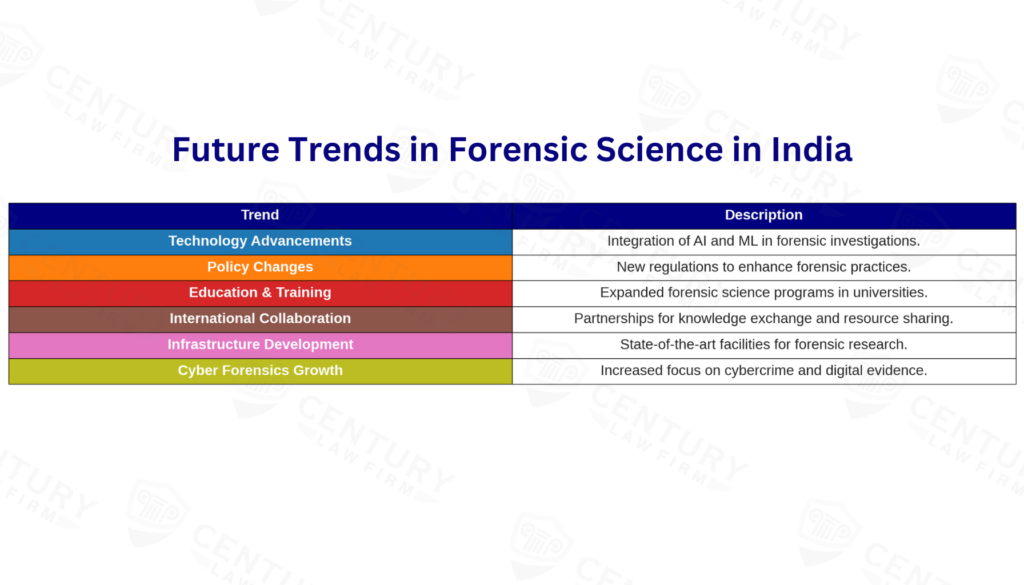
In conclusion, the role and admissibility of forensic evidence in the Indian criminal justice system are dynamic and evolving. While challenges persist, the trajectory is towards a more robust, scientific, and rights-conscious application of forensic evidence. The continued dialogue between legal and scientific communities, coupled with technological advancements, promises a future where forensic science can significantly contribute to the delivery of justice.
7. Current Challenges and Limitations
The application of forensic science within India’s legal framework is confronted with various challenges that impede its effectiveness and reliability.
a. Bridging the Gap Between Law and Science
The nexus between law and science is intricate, often leading to misinterpretations of forensic evidence in the courtroom. There is a pressing need for:
- Legal Training in Forensic Science: Judges and lawyers require better training in forensic science to make informed decisions.
- Scientific Awareness: Forensic scientists must also understand the legal implications of their work to provide clearer, more relevant testimony.
b. Infrastructure and Technological Constraints
Forensic laboratories in India face significant infrastructural and technological challenges:
- Outdated Equipment: Many labs are working with outdated technology that can’t keep pace with modern forensic science demands.
- Lack of Accreditation: Not all forensic laboratories are accredited, raising concerns about the standards of testing and evidence integrity.
c. Ethical Dilemmas in Forensic Investigation
Forensic professionals often encounter ethical dilemmas, such as:
- Privacy Concerns: The use of DNA databases raises privacy issues, necessitating stringent data protection laws.
- Consent for Testing: Obtaining informed consent for collecting DNA samples, especially in sensitive cases, remains a contentious issue.
d. Quality Control and Accreditation of Forensic Laboratories
The credibility of forensic evidence is directly linked to the quality of the laboratory it originates from. Steps to ensure this include:
- Standardizing Protocols: There is a need for standardized protocols across all forensic laboratories.
- Regular Audits and Accreditation: Regular audits and mandatory accreditation of forensic labs can ensure adherence to quality standards.
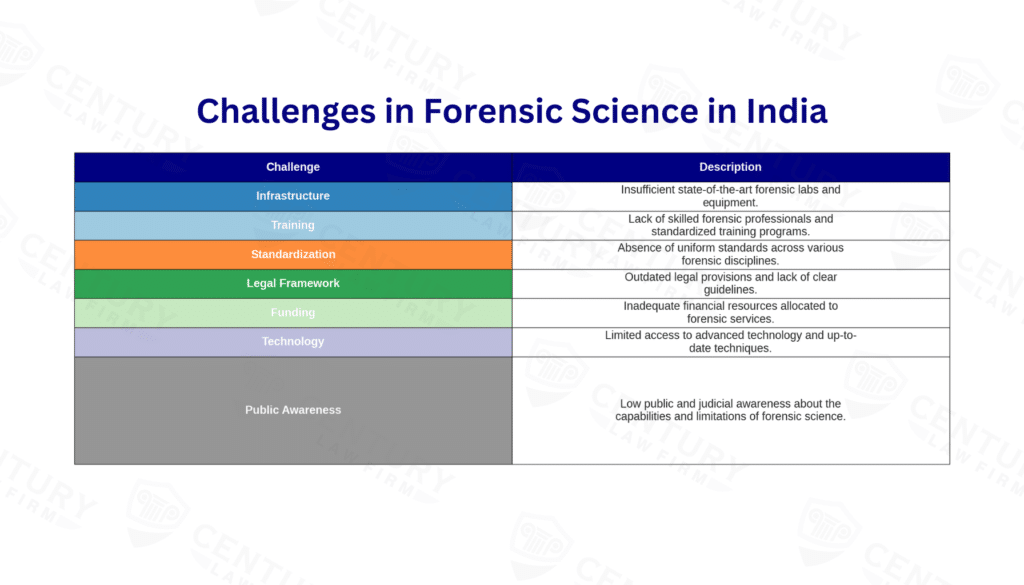
The advancement of forensic science in India is contingent upon overcoming these challenges through concerted efforts from the government, judicial system, and scientific community.
8. Role of Forensic Science in Special Types of Crime
Forensic science plays a distinctive role in investigating and solving various categories of crime.
a. Analysis of Violent Crimes: Homicide and Assault
Forensic evidence like DNA, blood spatter patterns, and ballistic reports are pivotal in solving homicides and assaults. These methods can reconstruct crime scenes and establish the sequence of events.
b. Forensic Science in Sexual Offences: Consent and Identification Issues
DNA evidence has become a cornerstone in adjudicating sexual offences. It’s crucial for identifying perpetrators and addressing the complex issue of consent.
c. Economic Offences and Fraud: The Role of Document Examination
Document examination, including handwriting analysis and the authentication of documents, is vital in uncovering economic offences and fraud.
d. Counter-Terrorism and National Security: Forensic Intelligence
In the realm of counter-terrorism, forensic intelligence—such as the analysis of explosive residues and digital footprints—is critical for national security and the prevention of future attacks.
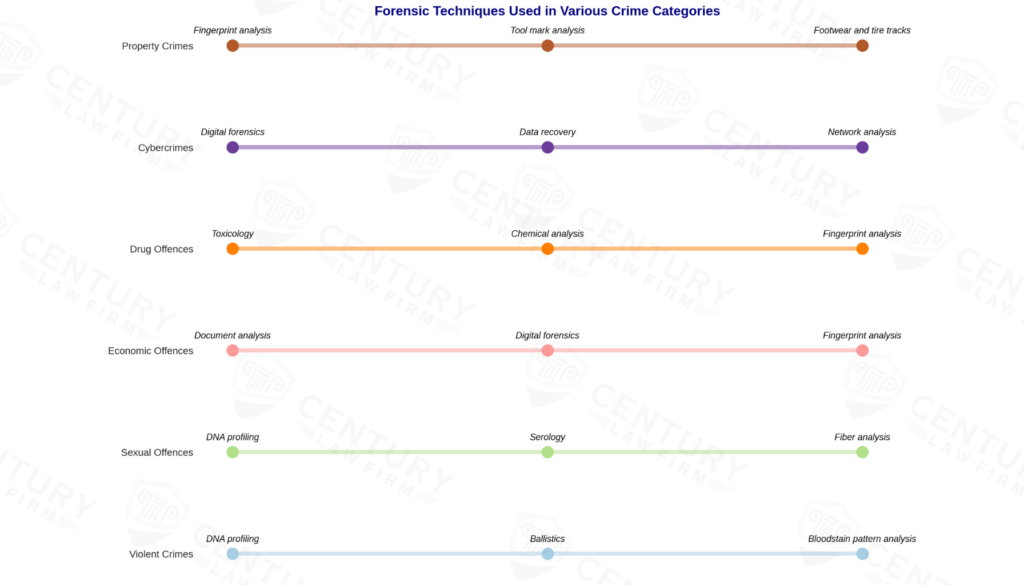
The role of forensic science extends beyond the courtroom, serving as a tool for both justice and prevention in various types of crimes.
9. The Road Ahead
The path forward for forensic science in India involves embracing advancements and ensuring a collaborative effort towards a more efficient and scientifically robust legal system.
a. Latest Developments in Forensic Techniques
Emerging techniques like next-generation sequencing (NGS) for DNA analysis and advanced cyber-forensics tools are set to revolutionize the field. virtual autopsy using medical imaging, and forensic genealogy are also set to expand the scope of forensic science.
b. The Need for Comprehensive Forensic Laws
There is an urgent need for comprehensive legislation that addresses the use, standardization, and ethical implications of forensic science.
c. Training, Education, and Capacity Building
Investing in education and training programs for forensic professionals is essential to build capacity and maintain high standards of practice.
d. International Collaboration and Exchange Programs
Collaborative efforts with international forensic institutions can lead to knowledge exchange and the improvement of forensic standards.
e. Recent Innovations
The Indian government’s push for upgrading forensic labs and automating DNA analysis promises a more efficient and accurate future for forensic investigations.
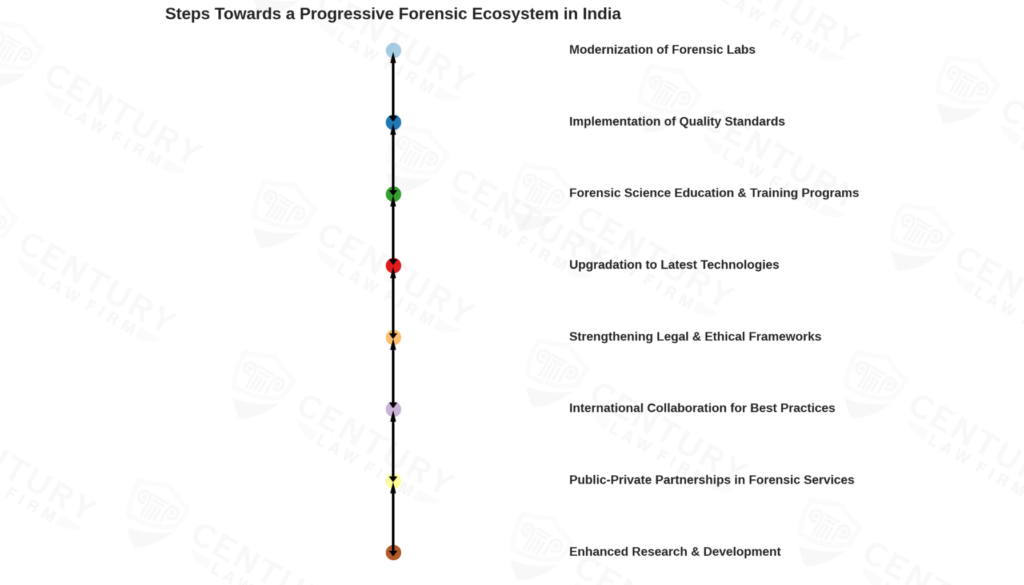
As India looks to the future, the potential for forensic science to contribute to the criminal justice system is vast, provided there is a commitment to continuous improvement and innovation.
10. Conclusion
The integration of forensic evidence is imperative for reinforcing the pillars of justice. Policy recommendations and future research must focus on:
- Strengthening Forensic Infrastructure: Upgrading facilities and technology to global standards.
- Enhancing Legal Frameworks: Establishing comprehensive laws that govern forensic procedures and evidence admissibility.
- Capacity Building: Fostering expertise through education and continuous professional development.
The vision for an evolved Indian forensic ecosystem is of a system that is transparent, efficient, and ethically responsible, contributing significantly to the pursuit of justice.
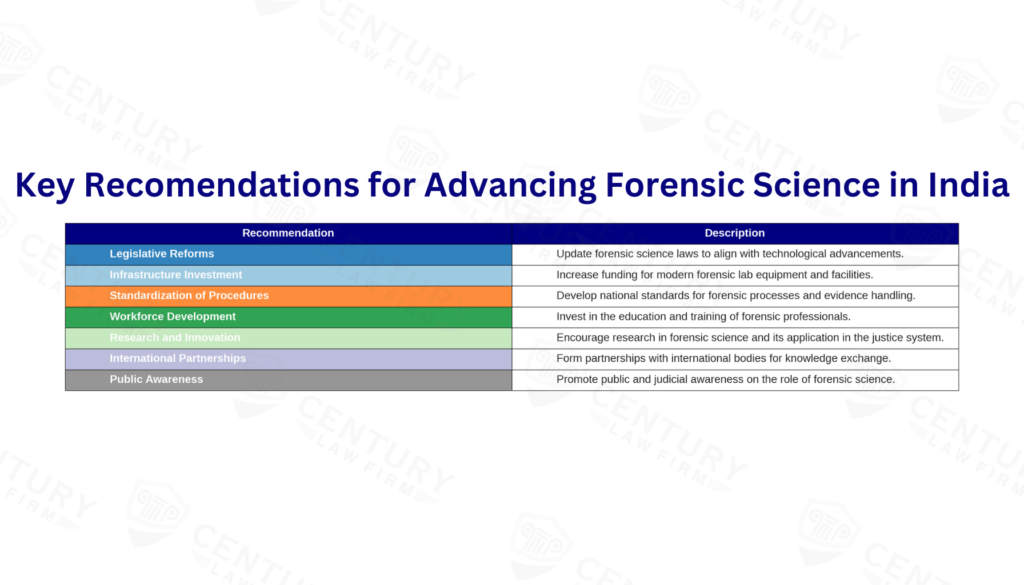
In conclusion, forensic science stands as a beacon of truth in the complex landscape of criminal justice. With concerted efforts from all stakeholders, India can surmount current challenges and harness the full potential of forensic science. There is also a need to fund R&D on cost-effective indigenous forensic techniques suitable for Indian conditions.
11. Appendix A – Glossary of Forensic Terms:
- DNA Profiling – Identifying individuals by analyzing sections of DNA that are unique.
- Ballistics – Scientific examination of firearm usage through analysis of bullets, cartridges etc.
- Toxicology – Detection and analysis of poisons or drugs present in biological samples.
- Trace Evidence – Transfer materials like hair, fibers, soil left at scene of crime.
- Fingerprint Analysis – Identification technique comparing fingerprints found at scene with database.
- Digital Forensics – Recovery and analysis of data from computers, mobiles and electronic devices.
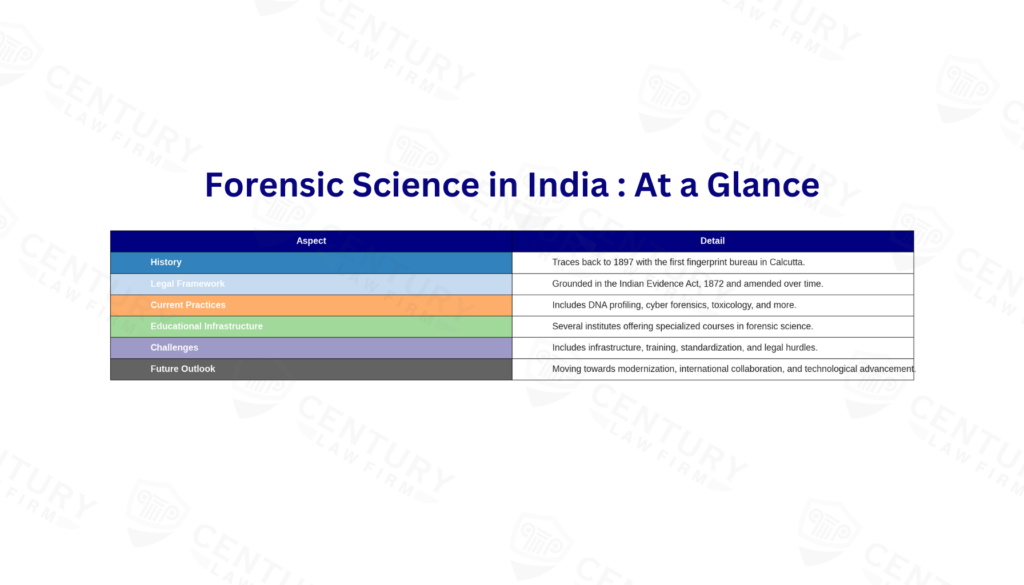
12. FAQs on Forensic Science and Evidence
Q: What is forensic science?
A: Forensic science is the application of science and technology to investigate crimes and establish facts that can be presented in legal proceedings.
Q: What are the main types of forensic evidence?
A: The key types of forensic evidence are DNA, fingerprints, ballistics, digital evidence, and forensic psychology assessments.
Q: When was the first forensic lab set up in India?
A: The first state forensic laboratory in India was set up in Calcutta (Kolkata) in 1952.
Q: What is DNA profiling?
A: DNA profiling is the process of identifying individuals by analyzing sections of their DNA that are unique, except in identical twins.
Q: What is a polygraph test?
A: A polygraph test, commonly known as a lie detector test, is designed to detect deception by measuring changes in physiological indicators like pulse, respiration, blood pressure.
Q: What are some key Supreme Court judgements related to forensic evidence in India?
A: Some landmark SC judgements are Selvi vs State of Karnataka on guidelines for narcoanalysis and brain mapping tests.
Q: What is STR analysis in DNA profiling?
A: STR stands for Short Tandem Repeat analysis. It looks at specific regions in DNA that contain short sequences of genetic code that are repeated. The number of repeats at multiple locations forms a unique profile.
Q: What does chain of custody mean in forensic evidence?
A: Chain of custody refers to the chronological documentation of the seizure, custody, control, transfer, analysis, and disposition of physical or electronic evidence. It ensures the integrity of evidence presented in court.
Q: Why are accreditation and standardization important for forensic labs?
A: Accreditation and standardization ensure quality control and adherence to protocols in evidence testing. This enhances the credibility of forensic results produced by the labs.
Q: What legal remedies are available if flawed forensic evidence leads to a miscarriage of justice?
A: Options like filing appeal against conviction, review petition and writ petitions are available. Compensation can be claimed if the accused suffered imprisonment. The expert could also face culpability.
Q: How can principles of ethics and human rights be integrated into forensic evidence procedures?
A: By ensuring informed consent, developing stringent privacy laws, imposing restrictions on collection/use of personal data, and increased transparency in evidence gathering processes.
Q: What is forensic science’s role in tackling new age crimes like cyber fraud?
A: Digital forensic techniques are critical to gather electronic evidence by recovering deleted data from computers, mobiles and cloud services implicated in cybercrimes.
Q: How can forensic experts avoid cognitive biases when interpreting evidence?
A: By following standardized analysis protocols, getting peer reviews, declaring limitations upfront, and being aware of base rate fallacy, context bias, confirmation bias and other influences.
Q: How does trace evidence differ from direct evidence?
A: Trace evidence refers to physical material that is transferred from one location or person to another. It is often microscopic and requires scientific testing for analysis. Direct evidence, on the other hand, includes firsthand observations such as eyewitness testimony or a video recording.
Q: Can forensic evidence be used to exonerate individuals?
A: Yes, forensic evidence can be crucial in exonerating individuals wrongfully accused or convicted of crimes. DNA evidence, in particular, has been instrumental in overturning wrongful convictions.
Q: Can environmental factors affect forensic evidence?
A: Environmental factors such as temperature, humidity, and exposure to elements can significantly affect the preservation and analysis of forensic evidence. Biological samples can degrade, and chemical residues can evaporate or become contaminated, which is why proper collection and storage are crucial.
Q: What is the role of forensic anthropology in criminal investigations?
A: Forensic anthropology is the examination of human skeletal remains to determine the identity of unidentified bones, investigate cause of death, and assist in the detection of crime. It’s particularly useful in cases of mass disasters, war crimes, and unmarked graves.
Q: How has technology advanced the field of forensic science?
A: Technological advancements have revolutionized forensic science, introducing more accurate and sensitive analytical techniques, such as next-generation sequencing for DNA analysis, advanced imaging methods for crime scene reconstruction, and sophisticated software for pattern and data analysis.
Q: What is forensic psychology and how does it differ from forensic psychiatry?
A: Forensic psychology involves applying psychological principles to legal issues, such as assessing a defendant’s competency to stand trial or the reliability of eyewitness testimony. Forensic psychiatry is a medical field where the focus is on diagnosing and treating mental disorders within a legal context, often involving the assessment of criminal responsibility and fitness to plead.
Q: How do forensic scientists determine the time of death?
A: Forensic scientists estimate the time of death using several methods, including rigor mortis, livor mortis, body temperature, decomposition, and insect activity. Each method has its own set of limitations and is influenced by environmental conditions.
Q: What are the ethical considerations in forensic science?
A: Ethical considerations in forensic science include ensuring the accuracy and objectivity of evidence analysis, maintaining confidentiality, obtaining informed consent for DNA collection when applicable, and avoiding conflicts of interest that could impact the impartiality of the investigation.
Q: What is the role of forensic accounting in investigations?
A: Forensic accounting is the use of accounting skills to investigate fraud or embezzlement and to analyze financial information for use in legal proceedings. It’s commonly employed in cases of white-collar crime, financial disputes, and business valuations.
Q: How are digital devices analyzed in forensic investigations?
A: Digital devices are analyzed using forensic tools that can safely extract and preserve data, including deleted or encrypted files. This process, known as digital forensics, involves a detailed analysis of digital records to uncover evidence related to crimes such as fraud, cyberbullying, or unauthorized access.
Q: What is forensic pathology?
A: Forensic pathology is the branch of pathology that focuses on determining the cause of death by examining a corpse. A post-mortem examination, or autopsy, is performed by a forensic pathologist to discover the cause of death, especially in cases where foul play is suspected.
Q: How do forensic scientists ensure the integrity of evidence?
A: The integrity of evidence is maintained through the chain of custody, which documents the collection, transfer, analysis, and storage of evidence. Forensic scientists also adhere to strict standard operating procedures and protocols to prevent contamination or tampering.
Q: What is the difference between circumstantial evidence and direct evidence in a forensic context?
A: Direct evidence supports the truth of an assertion directly, without an intervening inference, like a witness testimony or video footage. Circumstantial evidence, however, requires that an inference be made between the evidence and the conclusion to be drawn, such as DNA found at a crime scene suggesting the presence of a suspect.
Q: How reliable are forensic methods like bite mark analysis or hair comparison?
A: Some forensic methods, such as bite mark analysis or hair comparison, have been criticized for their lack of scientific foundation and standardization. While they can provide investigative leads, their reliability as conclusive evidence is often questioned, and they are subject to scrutiny in the scientific and legal communities.
Q: What role does forensic entomology play in crime scene investigation?
A: Forensic entomology involves studying insect life cycles and behaviors to estimate the time of death. Insects found on decomposing remains can provide a timeline of when a person died, which can be critical in homicide investigations.
Q: How are fingerprints analyzed and matched in forensic investigations?
A: Fingerprints are analyzed based on their unique patterns of ridges and valleys. Experts use manual comparison along with automated fingerprint identification systems (AFIS) to match prints collected from a crime scene with those of known individuals in databases.
Q: What is forensic serology?
A: Forensic serology is the analysis and identification of blood and other body fluids (semen, saliva, sweat) at a crime scene. It involves blood type analysis, DNA profiling, and the application of various techniques to determine the source and significance of the biological evidence.
Q: How is gunshot residue tested for in forensic examinations?
A: Gunshot residue is tested using techniques like scanning electron microscopy or atomic absorption spectrometry. These methods detect the presence of particles that are expelled from a firearm when it is discharged, which can place a suspect at the scene of a shooting.
Q: What is the Daubert Standard, and how does it apply to forensic evidence?
A: The Daubert Standard is a legal precedent set by the Supreme Court that provides a rule of evidence regarding the admissibility of expert witnesses’ testimony. It requires that the forensic methods used are scientifically valid and applicable to the case at hand.
Q: Can forensic science solve crimes on its own?
A: While forensic science is a powerful tool in crime solving, it typically requires integration with other investigative methods, witness accounts, and intelligence gathering to build a strong case. Forensic evidence alone may not be sufficient to solve a crime or secure a conviction.
Q: What is forensic linguistics, and how is it used in investigations?
A: Forensic linguistics is the study of language and its use in legal settings. It involves analyzing written or spoken communication for authorship attribution, threat assessment, and the interpretation of statutory language or courtroom discourse.
Q: How is age estimation performed in forensic anthropology?
A: Age estimation in forensic anthropology is performed by examining skeletal features, such as the fusion of bone growth plates, dental development, and degenerative changes. These indicators can help estimate the age of deceased individuals, especially when other identification means are not available.
Q: What is the role of forensic botany in criminal cases?
A: Forensic botany involves using plant evidence to help solve criminal cases. This can include identifying plant residues on victims or suspects, analyzing pollen to place individuals at a particular location, or dating events based on plant growth patterns.
Q: How has forensic science evolved over the past century?
A: Forensic science has evolved from rudimentary analyses and reliance on non-specific tests to the use of sophisticated, precise, and highly individualized techniques such as DNA profiling. Technological advances have also enabled virtual crime scene reconstructions and real-time data analysis.
Q: What are the limitations of forensic evidence in cold cases?
A: In cold cases, forensic evidence may be limited by the degradation of biological samples over time, the original mishandling of evidence, or the lack of modern technology at the time of the initial investigation. However, advances in forensic science can sometimes breathe new life into these cases.
Q: What impact do TV shows and media have on public perception of forensic science?
A: TV shows and media often create a phenomenon called the “CSI effect,” which can lead to unrealistic public expectations about the speed, simplicity, and conclusiveness of forensic analysis. This can affect decisions and the perceived credibility of evidence in the courtroom.
Topics Covered: Introduction to forensic science and its role in the legal system, Definition and Scope of Forensic Evidence, Significance of Forensic Science in Modern Legal Systems, The Indian Context: An Overview, Types of Forensic Evidence, Historical Development of Forensic Science in India, The Genesis of Forensic Science in India, Milestone in Forensic Legislation, Key Judgements and Their Impact on Forensic Practices, Establishment of Forensic Science Labs in India, Legal Framework and Provision, The Indian Evidence Act 1872, Expert Testimony: Section 45 Analysis, Evidence Classification: Understanding Section 3, Procedural Laws: CrPC and IPC Overview, Jurisprudence and Precedents, Supreme Court Directives, High Court Observations, Lower Court Applications, Supreme Court Judgments Shaping Forensic Evidence Rules, Categorization of Forensic Evidence, Biological Evidence or Medical Forensics, DNA Profiling: Advancements and Applications, Blood Typing and Serological Analysis, Postmortem Reports, Medico-Legal Certificates (MLC), Physical Evidence, Fingerprinting Methods and Efficacy, Trace Evidence: Fibers Paint and Other Materials, Digital Forensics, Cybercrime Investigations, Data Recovery and Analysis, Chemical and Toxicological Evidence, Drug Analysis, Poison Detection, Psychological Forensics, Profiling and Behavioral Evidence, Lie Detector Techniques, Ballistic Evidence, Standard of Admissibility, The Four Aspects of Admissibility in Indian Law, Establishing the Chain of Custody, Accuracy Precision and Reliability of Forensic Methods, Understanding the Error Margins and Uncertainties in Forensic Evidence, Influence of Forensic Evidence on Judicial Decisions, Expert Witness Requirements in Indian Law, Practical Challenges and Future Outlook, Infrastructure and Resource Limitations, Training and Expertise of Forensic Professionals, Standardization and Quality Control, Legal Understanding of Forensic Science, Noteworthy Cases and Their Outcomes, Forensic Failures: Analysis of Wrongful Convictions, Comparative Study: Indian Cases and International Benchmarks, Forensic Science and Human Rights, Technological Advancements and Their Integration, International Cooperation in Forensic Investigations, Public Perception and Media Influence, Future Prospects, Role of Forensic Science in Special Types of Crime, Analysis of Violent Crimes: Homicide and Assault, Forensic Science in Sexual Offences: Consent and Identification Issues, Economic Offences and Fraud: The Role of Document Examination, Counter-Terrorism and National Security: Forensic Intelligence, The Road Ahead, Latest Developments in Forensic Techniques, The Need for Comprehensive Forensic Laws, Training Education and Capacity Building, International Collaboration and Exchange Programs, Recent Innovations, Conclusion, Appendix A – Glossary of Forensic Terms, FAQs on Forensic Science and Evidence.
Also Read:
Polygamy and Polygamous Marriages in India: An In-depth Look into Practices and Legal Framework
Bharatiya Nyaya Sanhita, Bharatiya Nagarik Suraksha Sanhita, and Bharatiya Sakshya Bills: An Analysis of the Reform of Indian Justice System
The Specific Relief Act (SRA), 1963: A Comprehensive Analysis

